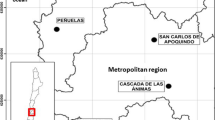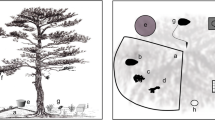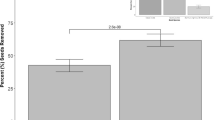Abstract
The effect of seed aggregation and distance from conspecific trees on seed predation was experimentally examined for two neotropical tree species, Macoubea guianensis (Apocynaceae) and Pouteria sp. (Sapotaceae) in a lowland tropical rain forest in northeastern Peru. Results of these experiments are discussed in the context of the Janzen-Connell model (Janzen 1970; Connell 1971), which predicts decreased seed survival near parent trees due to either density-or distance-responsive mortality, and Howe's model (Howe 1989) which predicts that trees with seeds dispersed in clumps (aggregated) will not suffer density-dependent predation, and will have higher survival of seeds near the parent tree than other trees. We also examined whether predation on seeds of these species was affected by seed placement in or near 30-m-wide strips regenerating after clear-cutting. Both species appeared to be mammal-dispersed but differed in how frugivores handled seeds, seed size, overall fruit crop size, and gemination time. Neither of the two species studied appeared to suffer seed predation in a manner predicted by the Janzen-Connell model, and patterns of seed predation for only one of the species was similar to predictions of Howe's model. For neither species did seed predation along the edge of, or in the center of, regenerating clear cuts differ from predation 15 m into the primary forest. For Pouteria, seed predation in and near regnerating strips was significantly greater than around forest trees, but the opposite pattern held for Macoubea. Overall, seed predation was much greater on Macoubea. The difference in seed predation for these two species was most likely a result of differences in the types of seed predators that attacked these two species.
Similar content being viewed by others

References
Augspurger CK (1984a) Seedling survival of tropical tree species: interactions of dispersal distance, light-gaps, and pathogens. Ecology 65:1705–1712
Augspurger CK (1984b) Pathogen mortality of tropical trees: changes in cohort distance with time Oecologia 61:211–217
Auguspurger CK, Kitajima K (1992) Experimental studies of seedling recruitment from contrasting seed distributions. Ecology 73:1270–1284
Clark DA, Clark DB (1992) Life history diversity of canopy and emergent trees in a neotropical rain forest. Ecol Monogr 62:315–344
Connell JH (1971) On the role of natural enemies in preventing competitive exclusion in some marine animals and in rain forest trees. In: Den Bour PJ, Gradwell PR (eds) Dynamics of populations. Center for Agricultural Publishing and Documentation. Wageningen, pp 298–312
De Steven D, Putz FE (1984) Impact of mammals on early recruitment of a tropical canopy trees Dipteryx panamensis, in Panama. Oikos 43:207–216
Emmons LH (1982) Ecology of Proechimys (Rodentia, Echimyidae) in South-eastern Peru. Trop Eco 23:280–290
Forget P-M (1992) Seed removal and seed fate in Gustavia superba (Lecythidaceae). Biotropica 24:408–414
Gorchov DL, Cornejo F, Ascorra C, Jaramillo M (1993) The role of seed dispersal in the natural regeneration of rain forest after strip-cutting in the Peruvian Amazon. Vegetatio 107/108:339–349
Hartshorn GS (1989) Application of gap theory to tropical forest management: natural regeneration on strip-cuts in the Peruvian Amazon. Ecology 70:567–569
Howe HF (1989) Scatter- and clump-dispersal and seedling demography: hypothesis and implications. Oecologia 79:417–426
Howe HF (1993) Aspects of variation in a neotropical seed dispersal system. Vegetatio 107/108:149–162
Janzen DH (1970) Herbivores and the number of tree species in tropical forests. Am Nat 104:501–528
Jordano P (1992) Fruits and frugivory. In: Fenner M (ed) Seeds: the ecology of regeneration in plant communities. CAB International, Wallingford, pp 105–156
Leigh EG, Wright SJ, Herre EA, Putz FE (1993) The decline of tree diversity on newly isolated tropical islands: a test of a null hypothesis and some implications. Evol Ecol 7:76–102
Levey DJ, Byrne MM (1993) Complex ant-plant interactions: rain forest ants as secondary dispersers and post-dispersal seed predators. Ecology 74:1802–1812
Loiselle BA (1990) Seeds in droppings of tropical fruit-eating birds: importance of considering seed composition. Oecologia 82:494–500
Notman E (1994) The effect of density, distance, and micro-habitat, on levels of seed predation for two neotropical trees. Masters thesis, University of Missouri, Saint Louis
Peters CM, Gentry AH, Mendelsohn RO (1989) Valuation of an Amazonian rainforest Nature 339:655–656
Pompa JF, Bongers F, Martinez-Ramos M, Veneklaas E (1988) Pioneer species distribution in treefall gaps in neotropical rain forest: a gap definition and its consequences. J Trop Ecol 4:77–88
Pyke DA, Thompson JN (1986) Statistical analysis of survival and removal rate experiments. Ecology 67:240–245
SAS (1989) SAS/STAT user's guide, version 6, 4th edn, v1&2. SAS Institute, Cary
Samper CK (1992) Natural disturbance and plant establishment in an Andean cloud forest. Ph D Thesis, Harvard University, Cambridge
Schupp EW (1988a) Factors affecting post-dispersal seed survival in a tropical forest. Oecologia 76:525–530
Schupp EW (1988b) Seed and early seedling predation in the forest understory and in treefall gaps. Oikos 51:71–78
Schupp EW (1993) Quantity, quality and the effectiveness of seed dispersal by animals. Vegetatio 107/108:15–29
Schupp EW (1995) Seed-seedling conflicts, habitat choice, and patterns of plant recruitment. Am J Bot 82:399–409
Schupp EW, Frost EW (1989) Differential predation of Welfia georgii seeds in treefall gaps and the forest understory. Biotropica 21:200–203
Schupp EW, Howe HF, Augspurger CK, Levey DJ (1989) Arrival and survival in tropical treefall gaps. Ecology 70:562–564
Sork VL (1987) Effects of predation and light on seedling establishment in Gustavia superba. Ecology 68:1341–1350
Spichiger L, Meroz J, Loizeau PA, de Ortega S (1989) Contribucion a la Flora de la Amazonia Peruana. Los arboles del arboretum Jenero Herrera, vol 1. Conservatiore et Jardin Botaniques de Genève) Switzerland
Terborgh J (1992) Maintenance of diversity in tropical forests. Biotropica 24:283–292
Roosmalen MGM van (1985) Fruits of the Guianan flora. Institute of Systematic Botany, Utrecht University, Netherlands
Willson MF (1992) The ecology of seed dispersal. In: Fenner M (ed) Seeds: the ecology of regeneration in plant communities. CAB. International, Wallingford, pp 61–86
Willson MF (1993) Dispersal mode, seed shadows, and colonization patterns. Vegetatio 107/108:261–280
Wright SJ (1983) The dispersion of eggs by a bruchid beetle among Scheelea palm seeds and the effect of distance to the parent palm. Ecology 64:1016–1021
Zar JH (1985) Biostatistical analysis. Prentice-Hall, Englewood Cliffs
Author information
Authors and Affiliations
Rights and permissions
About this article
Cite this article
Notman, E., Gorchov, D.L. & Cornejo, F. Effect of distance, aggregation, and habitat on levels of seed predation for two mammal — dispersed neotropical rain forest tree species. Oecologia 106, 221–227 (1996). https://doi.org/10.1007/BF00328602
Received:
Accepted:
Issue Date:
DOI: https://doi.org/10.1007/BF00328602



